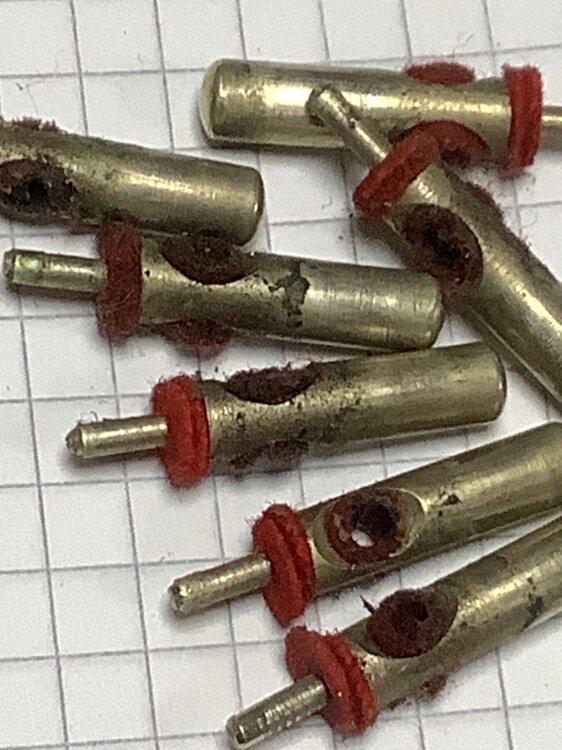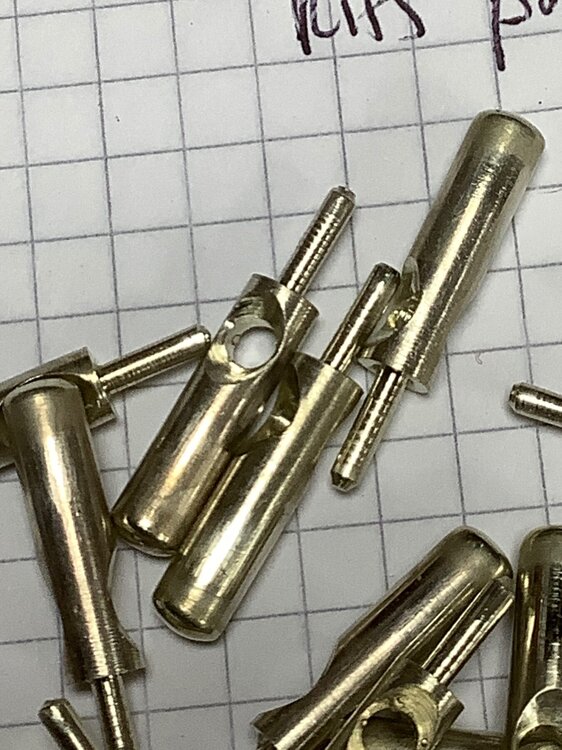-
Posts
2,094 -
Joined
-
Last visited
Posts posted by Theo
-
-
2 hours ago, Tiposx said:
Theo Gibb (The Box Place) in the UK has a 20 button D/A for sale, I don’t know if he exports.
Yes I can send to USA.
-
13 hours ago, seanc said:
The little inside info I have is that at least antiques road show is mostly staged… at least in the us.
meaning the items are all vetted/ assessed/ valued by staffers. the intersting story pieces and pushed on to the celebrities with the camera crews. Much of the expert’s script is written out And any sale has been agreed to well before the cameras are running.
Well of course they are TV shows and as such have various degrees of scripting/editing/production. Nonetheless they can give you an insight into a the process of polite hard bargaining. Real life may not be so pleasant, I'm sure we've all had interactions with our fellow humans where things didn't go as smoothly as we would have liked. Example: I once experienced an unprovoked verbal assault from a complete stranger, eventually they huffed off. When I described the incident to a wise friend he consoled me with the thought that although I would probably never see the person again, they would have to continue living with their own anger. So if people get worked up and appear angry because you prefer not to accept their offer, don't take it personally, just let them go.
-
Selling things is not as easy as it might appear! That's why so may people have paying jobs selling things. It's bit of a game really, Sometimes the hardest part is treating people politely when they are rude. There is an art to negotiating prices without demeaning the other party, or the object being sold. In the UK there is a TV series called Salvage Hunters where the dealer at the centre of things is an absolute master of the being hard-nosed but keeping things polite and friendly. I've pinched a few of his nice phrases that smooth the process.
-
 2
2
-
-
Two stages to this:
1 learning the tune so you can sing it, which just requires time spent listening, and that can be live music or recordings.
2 learning to put the tune in your head into your fingers on the instrument. They are very different skills and I think you can make better progress if you recognise that and adopt a learning strategy to suit.
-
 1
1
-
-
It's quite normal for some reeds to be shorter than their slots. These reeds all look perfectly usable, though of course I can't tell from a photo if the reddens have been filed excessively. The amount of filing doesn't look excessive. How do the reeds respond? That is the important question. I think you may be being overly pessimistic.
-
 1
1
-
-
41 minutes ago, Richard Mellish said:
Anyway further retuning of those that are neither at their original pitches nor at the correct pitches would seem a step too far. I am therefore looking at replacement of many reeds, possibly all of them.
Don't be too hasty to discard reeds. The originals in that instrument will be some of Lachenals best quality. Replacing them with easily available reeds may not be an improvement. Looking at the picture the filing seems to have been done carefully, so only reject reeds after they have proven themselves to play poorly.
-
Two things that can dull the sound of a reed - 1 valve not opening far enough. 2 reed not held snugly in reed pan.
-
How far can you take a reed? There is not one simple answer. The biggest factor is the starting pitch. In very general terms there are two extremes with gradual change between. Very low reeds with thick or weighted tips can be tuned up, often by several semitones, by removing metal from the tip. Very high pitch reeds can be tuned down by several semitones by removing metal from the lower part. Reeds of any pitch can also be lowered by tip loading. But any of these changes can degrade the performance of the reed, so you have to learn by experience how far is acceptable. Too much tip loading and the reed starts more slowly and volume is reduced. Too much filing to lower the pitch, and the pitch becomes unstable, going flatter as the reed is driven harder.
-
 1
1
-
-
It is entirely possible to build a decent sounding anglo using accordion reeds. The late Paul Harvey made may such concertinas and built up quite a successful small market selling them under the name Flying Duck Concertinas. The trick is to take an accordion reed that has two tongues of the same pitch and tune one up and the other down to make the note combination that you need. It takes some experience to do this but you need only simple hand tools and some trial and error. Expect to wreck a few reeds as you learn. Eddy Jay who specialises in 3D printed concertinas also stared off with salvaged accordion reeds.
-
37 minutes ago, harpomatic said:
It is a scam, the guy doesn't have this concertina in his possession, I checked. BTW, "our" SteveFile wasn't too keen on clarifying whether him and Kunder are one and the same person, thanks for nothing Steve!
And looking at the posting history of SteveFile he has only ever posted items for sale. Draw your own conclusions.
-
Clock cleaner really is the solution(ha!)
one brand, Horolene has already been mentioned. Place all the brass parts in the solution and leave overnight. Wash in hot water and dry. It works like magic. No time consuming mechanical cleaning required. When I’ve used it the parts have come out looking as if polished. It works on other non ferrous metals too. I’ve had good results on nickel buttons. It is designed to be used on delicate clock mechanic parts so I would not be concerned about using it on brass reeds. If the rivet is iron you would need to do some tests first.
I’m not sponsored by Horolene.
Before and after images of buttons. All I did was remove the felts. No mechanical cleaning or polishing.
-
 2
2
-
-
It's a straight copy of this advert on concertina.net from last year. Unless cnet member SteveFile and Kinder Lemison are the same person then it's a scam.
-
 1
1
-
-
I've seen anglo straps lined with felt, and I think you could also make a comfort lining with a soft kid or sheep clothing leather.
-
Good advice.
Make sure the edges of the cracks are not displaced up or down before gluing. Clamping to a flat surface is one option. Pva will creep over time so displaced cracks that have been clamped in position while gluing may move again. Hide glue and other protein base glued like rabbit skin, or fish glue are not subject to creep.
-
Quite a mix of advice there!
I repair both concertinas and melodeons and find there is very little in common with the construction of a Flutina. The reed pan is similar in its principles to a concertina reed pan but otherwise it’s best thought of aa a distinct member of the free reed family.
I have worked on a small number of Flutinas and I’ll share some of my experience. Reeds and valves are very similar to concertina parts. Mechanism is unique the the Flutina, and I’ve always found it very difficult to work on. It’s fragile, and difficult to dismantle. Bellows are beautifully made but the makers seem not to have considered how they might be repaired. A bookbinder would have the skills and materials to do repairs.
I’ve now stopped even attempting Flutina repairs except for the simplest tasks. If you want to learn free reed repair the Flutina is probably not the instrument to learn on!
-
19 minutes ago, Anglo-Irishman said:
There's a theory that, if you're musical, it doesn't really matter what instrument you play. A good start is an instrument that your Mum or Dad plays, because it's available, and there's someone in the house who can tell you how to "operate" it. Or an instrument that some deceased relative bequeaths to you. Or one you find in a pawn shop, or get very cheap online, etc. etc.
Sound advice! No harm in asking others for their experience but the most important thing is to get started. It's easy to overthink the choice before you've tried to play. Just get the instrument that is easily available/within your budget and dive in!
-
 1
1
-
-
You need a bit of experience to fix the subtle problems you've described. You will probably do just as well selling or trading it in as it is.
There's another two digits of the serial number on the red pan making 195632 which would be from the early 1920s
-
2 minutes ago, HansQ said:
I am still curious to hear the motivations....or is it all transcendental ? 🙂
My guess (no more than a guess) is that the motivation was marketing. From the late 19th C there seems to have been an innovation arms race between Lachenal and Wheatstone. Possibly something like this:
Lachenal New Model introduced raised ends
Wheatstone responds with Aeola with 8 sides and raised ends (I know I'm simplifying the evolution of the Aeola)
Lachenal responds with Edeophone with raised ends and 12 sides
Bowing valves probably come somewhere in there too.
-
A couple of things to bear in mind about reeds. For a given pitch there is a length of reed tongue which works best. Actually there is a small range of lengths but we can set that on one side here. In the midrange of pitch the reeds are close to the ideal length, higher pitches get progressively longer than their ideal pitch, and for lower pitches the reeds get progressively shorter than ideal.
So for high pitches you can lower the pitch without compromising the reed by filing metal from the lower third of the tongue. Loading the tip with solder in this range will result in a dull sounding reed.
For low pitch reeds you can raise the pitch by removing metal from the tip where you will find the full thickness of steel, or even a brass wight soldered on. You can also lower the pitch of low reeds by tip loading.
In the mid range you can use either method.
I am deliberately avoiding giving numbers to say you can go up or down by a certain number of semitones because it depends on the pitch you start with, and it also depends on other factors to do with the details of how the reed has been made. With practice, and using the guidelines above you will be able to learn by experience what works and what does not work. You may wreck a few reeds, but see that as a learning opportunity, and not an error.
-
Another useful source of clothing leather is to buy leather garments from charity shops — I think you call them thrift stores.
-
I have no experience with deer leather. The kind of tanning is equally important, so depends on the process. Making good leather is a slow process so if deer leather is available during or shortly after the hunting season it may not be fully tanned.
-
Clothing leather will have the flexibility you need, in the U.K. it’s often called Nappa. Sheep or goat should work. Goat is a bit tougher, but sheep nappa is easier to find.
-
 1
1
-
-
Perfectly normal.
-
 1
1
-
-
3 hours ago, Daniel Hersh said:9 hours ago, Chemnitzer said:
So, l see used 30-key English concertinas for about £280-£380. Taking my cue from that, my concertina could never be £300.
Read Theo's response again, and be aware that he is writing from his experience as an established concertina and accordion restorer and dealer. What it's worth is what someone is willing to pay for it.
Yes, and size and number of buttons is not really relevant. The value of 30 key (anglo) is supported by a huge international market of people who play Irish music.
To take an opposite example: you could compare the vale of a 120 bass piano accordion from the 1930s (which is when your Scheffler was likely made) which has more buttons and keys. These can have highly ornate inlay work and be of similar build similar quality to the Scheffler. Even in playable condition these are virtually unsaleable and their value is mostly just for use as spare parts.





Advice for thickness of leather for bellows
in Instrument Construction & Repair
Posted
Going back to paring knives, I've had a similar frustrating experience with a Scharf Fix and now use one of these simple knives. It took me a long time to learn how to sharpen it properly but once sharp it's very quick and effective and just needs the edge to be refreshed on a leather strop after every couple of metres of cut. My sharpening mentor describes the degree of sharpness to be such that if you drop the knife your would be worried about your feet!
https://www.hewitonline.com/Standard_English_Paring_Knife_p/tl-070-pk.htm